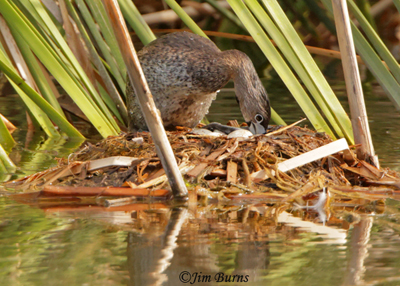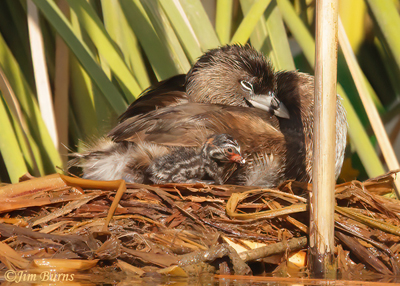
Young grebes riding on parents’ backs is a photo cliché. It’s one I’ve never shot but has long been on my photo bucket list, so here I was after lunch on a 105 degree August afternoon at my local patch, dragonflies on my mind. Glassing across the water I saw a Pied-billed Grebe at the edge of the reeds on the opposite side. Mindlessly, I noticed it was out of the water. Wait, what! Since I had never found a Pied-billed nest, I had never seen a Pied-billed out of the water. This grebe was on the water side of a thick reed bed growing out from the rocks on the shore behind it. The grebe was, indeed, out of the water, standing on . . . a nest mound!
It took me a minute because it seemed wrong time of day, wrong time of year, totally wrong place for a nest, exposed to the elements and predators. It didn’t make sense until I realized this must be a second clutch; and the parks department had dredged out huge sections of the reedbeds in all of the ponds. This grebe pair must have been displaced from their normal nesting areas deep in the reeds. At this point the grebe stepped down off the nest, pulled dead reeds up over the top of the mound, and swam out into the pond. When it soon returned and rearranged some of the reeds, I could see three eggs. Suddenly dragonflies were the furthest thing from my mind. This became Day One of an all week vigil. A vigil all too short as it turned out.
On Day Two when I arrived bright and early, having done some Pied-billed research, a parent was again on the nest. I now knew that incubation was by both parents, but I had only seen one bird around the day before. It wasn’t long, though, before I saw a second adult coming to the nest, and when the pair switched places I again counted three eggs. All seemed well, but late that afternoon the monsoon thunderstorms migrated all the way into the Valley and dumped over an inch of rain.
Day Three dawned clear and bright, and I was greeted at the grebe nest by one parent, only two eggs, but one tiny chick paddling around the nest and huddling under the adult’s wing as it incubated. Yes! Hatchling grebes can swim almost immediately after they come out of the egg and, mesmerized by the interaction between chick and parent, I hung around the entire morning, my concern growing because I never saw the second parent.
Hatchling Pied-billeds are not “mini-mes” like young Killdeer but they are outrageously cute, entire body and head striped black and white, an orange spot on the back of the head and a bright orange bill. They sport the beginnings of a tiny black circle on the upper mandible, its tip bright white which may serve the same purpose as the gape mark does for many other species. Young grebes are totally ungainly out of the water, and I watched five full minutes of backsliding as this one tried to climb the parent’s slippery feathers to roost under a wing.
I began wondering, on Day Four after another overnight rain, why neither of the remaining eggs had hatched. It seemed odd that there would be a two day discrepancy in egg development, and once again the second parent was nowhere to be seen. I was able to photograph one of the chick’s first meals, apparently vegetable matter brought by the parent and eagerly devoured by the begging youngster, its whole body only about the size of the adult’s head.
On Day Five, the only dawn on a cloudy morning after yet another overnight rain, was the dawn of reality that began to come over me. Though there was again an adult grebe sitting on the mound, the nest looked somehow different. At first I could not tell for sure why. There was no second parent in sight anywhere on the pond and, more ominously, I couldn’t find the baby. Assuming it was probably just hiding back in the reeds, I glassed for half an hour to no avail. At that point the adult left the mound, still with two visible eggs, and paddled off without covering them.
As I studied the morning’s obligatory first snapshot of the nest on the back of the camera, I finally realized what was becoming painfully evident. The mound looked smaller, lower in the water, closer to the water’s edge, its reed foundation now all soaked and soggy. The next two hours were spent watching the lone adult grebe surveying the pond edges for Crayfish, never returning to the nest. The nest had failed, the single hatchling had not made it, and the remaining parent had probably sensed this failure a day or so before I knew.
Sadly I realized I had just witnessed a microcosm of our own species demise as oceans rise amidst all the signs we’ve failed to recognize. Ever since actively participating in the culture wars of the sixties, I have been optimistic about the planet. Though I am loathe to admit it, this summer’s experience with my grebes’ monsoon disaster has given pause to that optimism. As former President Bill Clinton recently said as he reconvened his Global Initiative conference, “the world is on fire in so many ways.”
The grebes are us. “This may be the last time . . . ”*
*A Black spiritual first popularized by the Staple Singers, then reimagined by the Rolling Stones.
